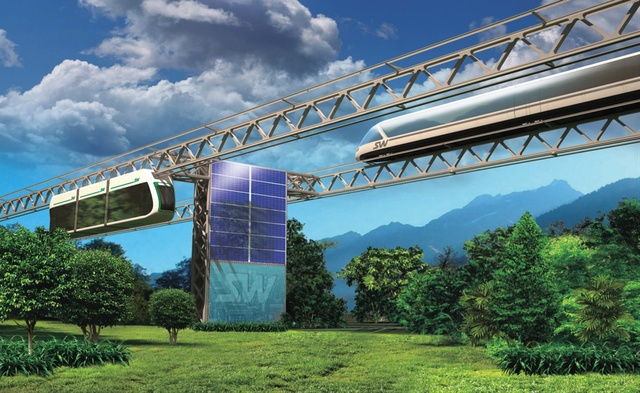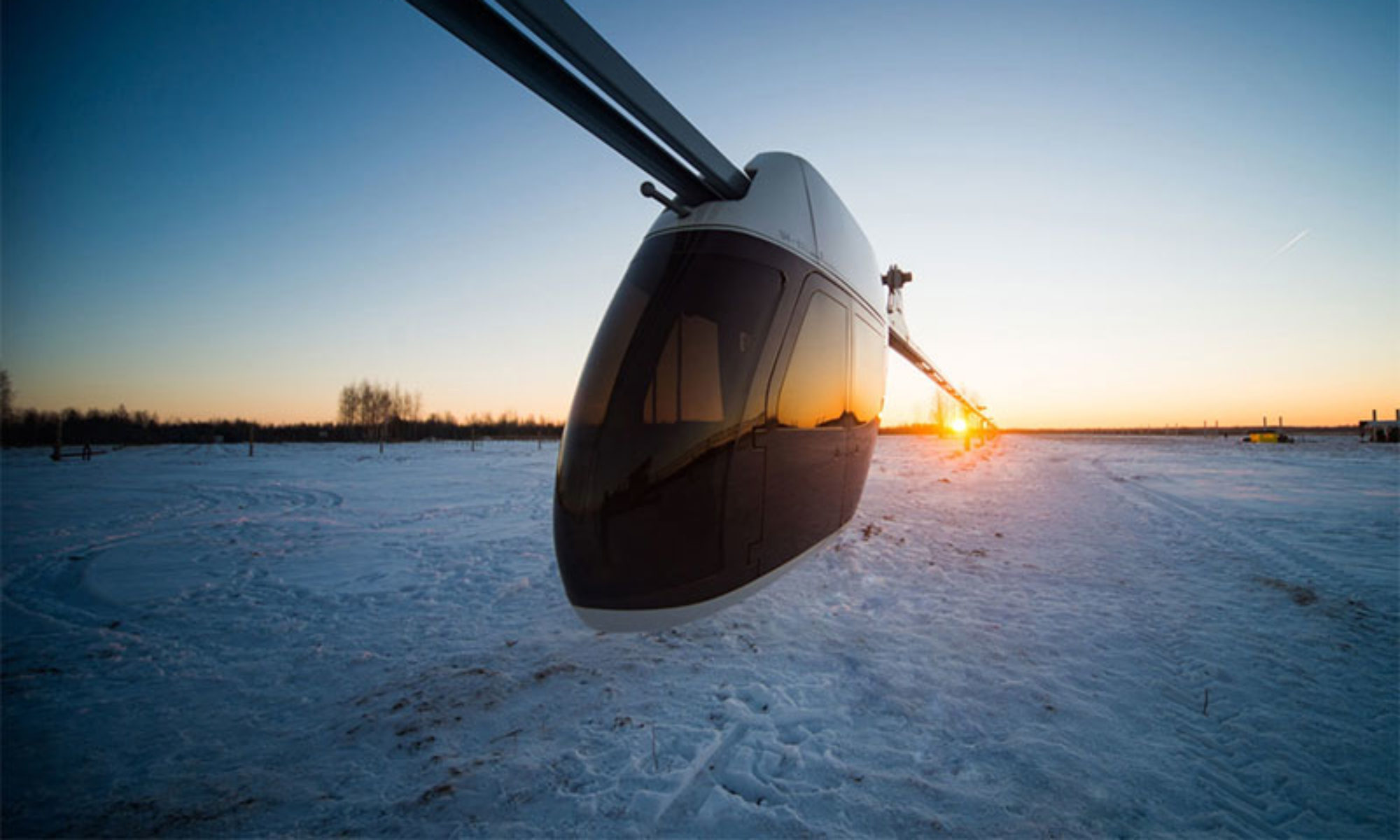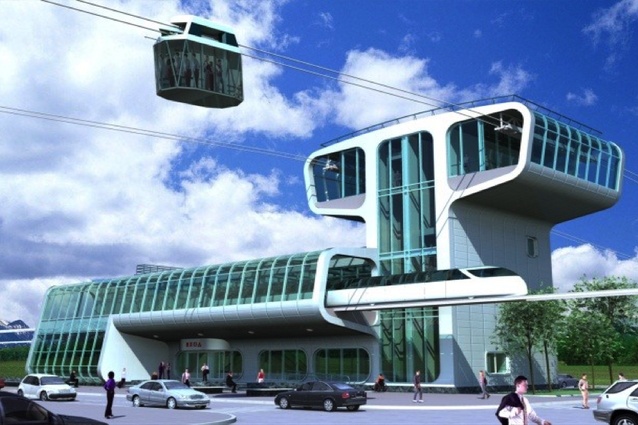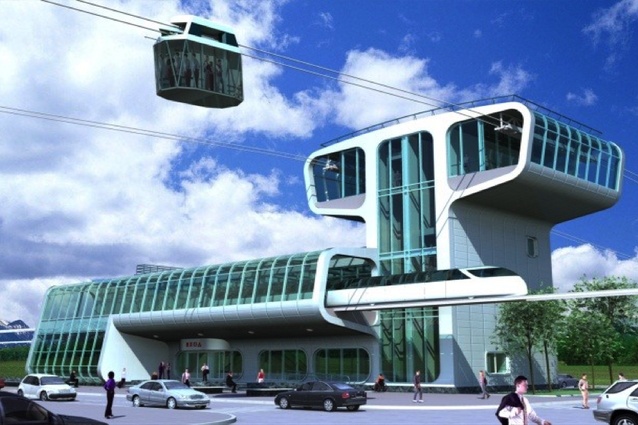 A mund të zgjidhë një tren pa shofer dhe i ngritur ne ajer problemet e transportit në Australi?
A mund të zgjidhë një tren pa shofer dhe i ngritur ne ajer problemet e transportit në Australi?
Shkruar nga Linda Cheng © . Propozim konceptual për një hekurudhë të ngritur Sky Way në Universitetin Flinders.
Një propozim i një zyrtari të mëparshëm publik në Australinë e Jugut mund të shihte një sistem te binareve te ngritur pa drejtues dhe me bateri, të paraqitur në Universitetin Flinders në Adelaide.
Sistemi ekskluziv i transportit i shkeputur prej tokës, i njohur si “Sky Way“, ka automjete autonome qe punojne me bateri që vetengarkohen. Teknologjia u zhvillua nga një inxhinier me përvojë në programin hapësinor rus dhe u soll në #Australi nga biznesmeni #RodHook, i cili është ish-drejtor ekzekutiv i Departamentit të Planifikimit të Transportit dhe Infrastrukturës në Australinë Jugore.
Hook tha se sistemi Sky Way është në gjendje të kalojë nëpër qytete, te lidhe qendra ekstra-urbane me shpejtësi të lartë dhe tranzit mallrash.
Sistemi gjithashtu është me sa duket më efikas, më ekologjikr dhe “dukshëm më i lirë” se sa tramvajet tradicionale dhe trenat hekurudhorë.
“Trenat dhe tramvajet zakonisht kalojnë nëpër qytete, nëpër tokë bujqësore ose në brendësi, nëpër qytete, do te duhet te ndërtojnë binare mbi tokë, krijojnë tynele, tjetërsojnë tokën ose përpiqen të gjejnë hapësirë në qytete, ndoshta në rrugët ku këto gjëra mund të mbeshteten, “shpjegoi Hook.
“Rruga SkyWay shkon mbi to, kështu që ne nuk kemi probleme me tokën , nuk kemi probleme me mbingarkesë, nuk kemi probleme sigurie në vendin ku tramvajet dhe trenat kanë kalime në nivel.
“Unë mendoj se ne ofrojmë një zgjidhje që nuk është eshte e mundur me një linjë hekurudhore ose një linjë tramvaji“.
Hook gjithashtu tha se sistemi ndryshon nga një monorail, sepse sistemi SkyWay shkon në dy shina në vend të një dhe është gjithashtu i aftë për shpejtësi më të larta se sa ish-korridori i Sidneit i cili eshte mbyllur në vitin 2013.
Rod Hook dhe Associates po bashkëpunon me Universitetin Flinders për të ndërtuar një pilot projekt 500 metrash në kampusin e Bedford Park, i cili do të lidhë qendrën kryesore të universitetit me stacionin e propozuar të Flinders, pjesë e zgjerimit të shtetit të vijës hekurudhore Tonsley.
Projekti Pilot duhet të kushtojë rreth 13 milionë dollarë. Për krahasim, zgjatja një kilometër e qeverisë së Australisë Jugore të vijës së tramvajit të Adelaide përgjatë Terrace Veriut duhet të kushtojë 50 milion dollarë.
“Nëse [Rruga SKYWAY ] është e mundshme, ajo ka potencial të jetë një kartë krediti për Australinë e Jugut dhe një komunitet shërbimi fantastik”, tha profesor Colin Stirling, zëvendëskryetar i Universitetit Flinders. “Kjo jo vetëm që do t’i përgjigjej një nevoje praktike, por do të ishte në vetvete një tërheqje vemendjeje, sepse nuk ka asgjë si ajo kudo tjetër nëper botë“.
Përveç kësaj, Rod Hook dhe Associates gjithashtu planifikon të ndërtojë një pistë testimi për një kilometër për të demonstruar potencialin e saj.
 Un treno senza conducente e sopraelevato potrebbe risolvere i problemi di trasporto in Australia?
Un treno senza conducente e sopraelevato potrebbe risolvere i problemi di trasporto in Australia?
Notizie – Linda Cheng
Proposta concettuale per una ferrovia sopraelevata Sky Way presso la Flinders University.
Proposta concettuale per una ferrovia sopraelevata Sky Way presso la Flinders University.
Immagine: Court Hook Hook and Associates ©
Una proposta di un ex funzionario pubblico nell’Australia del Sud potrebbe vedere un sistema di binari sopraelevato senza conducente, alimentato a batteria, introdotto alla Flinders University di Adelaide.
L’esclusivo sistema di trasporto di massa sopraelevato, noto come Sky Way, ha veicoli autonomi e funziona con batterie ricaricabili. La tecnologia è stata sviluppata da un ingegnere con esperienza nel programma spaziale russo e viene portata in Australia dall’uomo d’affari Rod Hook, che è l’ex amministratore delegato del Dipartimento di pianificazione dei trasporti e delle infrastrutture nell’Australia meridionale.
Hook ha affermato che il sistema Sky Way è in grado di transitare in città, treni interurbani ad alta velocità e transiti merci.
Il sistema è anche presumibilmente più efficiente, più ecologico e “significativamente più economico” rispetto ai tradizionali tram e treni ferroviari.
“I treni e i tram normalmente passano di livello attraverso le città, attraverso i terreni agricoli o nell’entroterra australiano. Devi costruire i binari sul terreno, corridoi, tunnel, alienando la terra o cercando di trovare spazio nelle città, probabilmente sulle strade in cui queste cose potrebbero appoggiarsi “, ha spiegato Hook.
“Sky Way va sopra le righe, quindi non abbiamo problemi con la terra straniante. Non abbiamo problemi con la congestione. Non abbiamo problemi di sicurezza sul posto dove tram e treni hanno passaggi a livello.
“Penso che offriamo una soluzione che non è disponibile con una linea ferroviaria o una linea del tram“.
Hook ha anche detto che il sistema si differenzia da una monorotaia perché il sistema funziona su due binari anziché su uno ed è anche capace di velocità più elevate rispetto all’ex monorotaia di Sydney che è stata chiusa nel 2013.
Rod Hook and Associates sta collaborando con la Flinders University per costruire un progetto pilota di 500 metri nel campus di Bedford Park, che collegherà l’hub centrale dell’università alla stazione di Flinders proposta – parte del progetto di estensione della linea ferroviaria Tonsley del governo statale.
Il pilota dovrebbe costare $ 13 milioni. A titolo di paragone, l’estensione di un chilometro del governo sud-australiano della linea del tram di Adelaide lungo North Terrace dovrebbe costare $ 50 milioni.
“Se [ la SkyWay ] è fattibile, ha il potenziale per essere un drawcard per il Sud Australia e una fantastica comunità di servizi”, ha affermato il professor Colin Stirling, vice-cancelliere della Flinders University. “Non solo risponderebbe a un’esigenza pratica, ma sarebbe di per sé un’attrazione perché non c’è niente di simile in nessun’altra parte del mondo.”
Inoltre, Rod Hook and Associates prevede anche di costruire una pista di prova di un chilometro per dimostrare il suo potenziale.
 Could a driverless, elevated rail solve Australia’s transport woes?
Could a driverless, elevated rail solve Australia’s transport woes?
A proposal by a former senior public servant in South Australia could see a driverless, battery-operated elevated rail system introduced at Flinders University in Adelaide.
The unique elevated mass-transit system, known as Sky Way, has autonomous vehicles and operates on rechargeable batteries. The technology has been developed by an engineer with experience in the Russian space program and is being brought to Australia by businessman Rod Hook, who is the ex-CEO of the Department of Planning Transport and Infrastructure in South Australia.
Hook said the Sky Way system is capable of urban transit, high-speed inter-city rail and freight transit.
The system is also purportedly more efficient, more environmentally friendly and “significantly cheaper” than traditional on-ground tram and train systems.
“Trains and trams normally go at grade through cities, across farmland or in outback Australia. You’re building the tracks on the ground, you’re building corridors, alienating land, or trying to find space in cities, probably on roads where these things might sit,” Hook explained.
“Sky Way goes over the top, so we don’t have issues with alienating land. We don’t have issues with congestion. We don’t have safety issues on the ground where trams and trains have level crossings.
“I think we offer a solution that isn’t available with a train line or a tram line.”
Hook also said the system differs from a monorail because the system operates on two rails rather than one and it’s also capable of faster speeds than the former Sydney monorail that closed in 2013.

Rod Hook and Associates is collaborating with Flinders University to possibly build a 500-metre pilot project at the Bedford Park campus, which will connect the university’s central hub to the proposed Flinders Station – part of the state government’s Tonsley rail line extension project.
The pilot is expected to cost $13 million. By way of comparison, the South Australian government’s one-kilometre extension of Adelaide’s tram line along North Terrace is expected to cost $50 million.
“If [the Sky Way] is feasible, it has the potential to be a drawcard for South Australia and a fantastic community amenity,” said professor Colin Stirling, vice-chancellor of Flinders University. “Not only would it address a practical need, but it would be an attraction in itself as there’s nothing like it anywhere else in the world.”
In addition, Rod Hook and Associates also plan to build a one-kilometre test track to demonstrate its potential.



